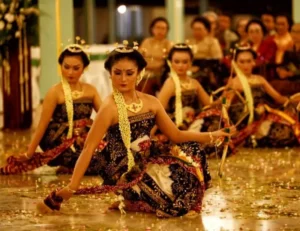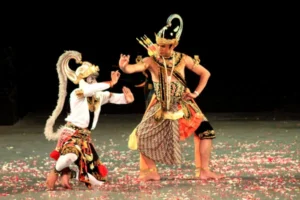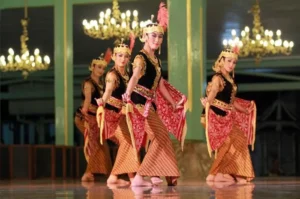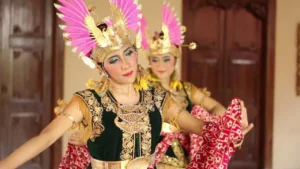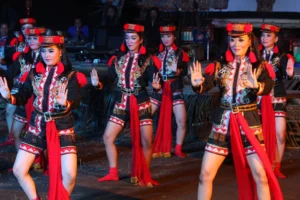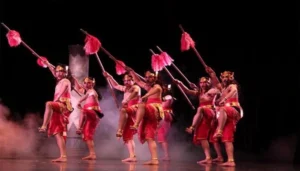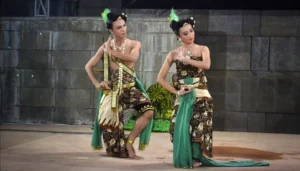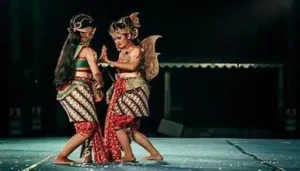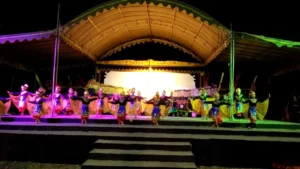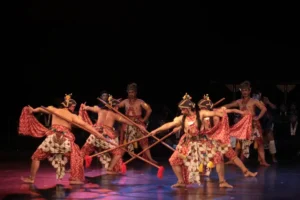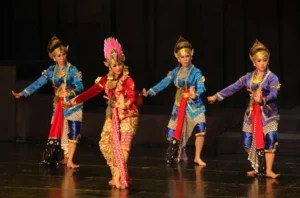Traditional dances of Yogyakarta are an integral part of Indonesia’s cultural wealth. As one of Indonesia’s cultural cities, Yogyakarta boasts a variety of fascinating traditional dances imbued with rich cultural values, history, and local wisdom. Each movement in Traditional Dances of Yogyakarta carries its own significance, depicting local life, beliefs, and culture. A famous example is the Srimpi dance, which showcases the grace and beauty of movements infused with the nuances of Yogyakarta’s natural beauty.
In addition, the Bedhaya Ketawang dance is also an inseparable element of Yogyakarta’s culture, considered a sacred dance performed only on special occasions at the royal palace. Preserving Traditional Dances of Yogyakarta is crucial not only for safeguarding the cultural wealth inherited from our ancestors but also for introducing and promoting the beauty and uniqueness of Indonesian culture worldwide. Therefore, the effort to preserve, teach, and practice Traditional Dances of Yogyakarta must be continuous to maintain the continuity of the national culture.
11 Traditional Dances of Yogyakarta
1.Bedhaya Ketawang Dance
source : sekolahnesia.com
The Bedhaya Ketawang dance, a cultural heritage of Traditional Dances of Yogyakarta, symbolizes the grandeur and magnificence of the Yogyakarta royal palace. This sacred dance has deep cultural roots, originating directly from the royal palace, a rich Javanese cultural center. Performed at special ceremonies in the palace, such as Grebeg Maulud or Grebeg Besar, the Bedhaya Ketawang creates a mystical and sacred atmosphere.
The graceful and delicate movements accompanied by Javanese gamelan music enhance the sense of grandeur in this dance. The grace and finesse of the dancers’ movements emanate from the richness of Javanese cultural philosophy. In their performance, the dancers wear magnificent traditional costumes adorned with palace ornaments, making them a true representation of the grandeur of the Yogyakarta royal palace.
By preserving the authenticity and integrity of this dance, dancers and culture enthusiasts in Yogyakarta contribute to the preservation and development of this invaluable cultural heritage. The Bedhaya Ketawang dance, as an integral part of Yogyakarta’s cultural heritage, plays a significant role in introducing and promoting Indonesia’s cultural richness worldwide.
2.Ramayana Dance
source : tarietradisionaljawa.blogspot.com
The Ramayana dance is a precious cultural heritage of Yogyakarta, Indonesia. Regularly performed on the Krapyak stage, this dance attracts attention with the graceful and dynamic beauty of its movements. From the abduction of Sita by Ravana to the epic battle between Rama and Ravana, each scene illustrates the power and beauty of the Ramayana story. Through this dance, the audience is not only captivated by visual beauty but also reminded of deep moral messages such as loyalty, courage, and kindness.
The Ramayana dance is one of the main attractions of cultural tourism in Yogyakarta. Each dance movement takes its audience on a captivating emotional journey. The beauty of this dance captivates not only the eyes but also touches the hearts of the audience with its moral messages. In daily life, these values remain relevant and can inspire many people to lead a life full of kindness and courage. This traditional dance of Yogyakarta is a symbol of cultural wealth that must be preserved and disseminated to remain an inseparable part of the national cultural identity.
3.Srimpi Dance
source : moondoggiesmusic.com
The Srimpi dance is one of Traditional Dances of Yogyakarta rooted in local culture for centuries. The grace and gentleness of this dance symbolize the beauty and harmony of Javanese culture. With gentle and magnificent movements, the Srimpi dance is often performed at various traditional events in Yogyakarta, such as weddings and receptions for important visitors.
The charm of the Srimpi dance lies not only in its movements but also in the costumes worn by the dancers. The gorgeous costumes with bright colors and traditional Javanese motifs add to the visual beauty of this dance. As an integral part of Yogyakarta’s culture, the Srimpi dance not only enriches the local cultural heritage but also symbolizes the diversity and beauty of Indonesian culture as a whole.
The presence of the Srimpi dance at various traditional ceremonies is evidence of the important role of traditional dances in preserving and strengthening the cultural identity of a region. By preserving and continuing to develop the Srimpi dance, Yogyakarta contributes to the preservation of invaluable cultural heritage for future generations.
4.Golek Ayun-Ayun Dance
source : youtube.com
The Golek Ayun-Ayun dance is one of the cultural treasures of the Yogyakarta region, also popular in some parts of Central Java. This dance is a symbol of joy and happiness for local residents and is an integral part of their tradition. With dynamic and passionate movements, the Golek Ayun-Ayun dance is often the main attraction at various cultural festivals and other traditional events in the region. The dancers wear colorful and bright costumes, emitting an irresistible charm for the audience. The accessories used in this dance add a magical touch to their performance.
Beyond mere entertainment, the Golek Ayun-Ayun dance plays an important role in strengthening fraternal and community ties in Yogyakarta society. Each executed movement not only reflects the beauty of art but also strengthens social ties between dancers and their audience. By preserving and developing cultural treasures like the Golek Ayun-Ayun dance, Yogyakarta society maintains its rich tradition-rich identity. Overall, this dance is not just a relic of the past to be preserved; it also reflects the evolving life and culture of the region.
5.Angguk Dance
source : tradisikita.my.id
The Angguk dance is one of the most distinctive forms of Traditional Dances of Yogyakarta. With gentle and meaningful movements, the Angguk dance is an important part of Indonesian cultural heritage, especially in the context of Yogyakarta culture. This traditional dance is usually performed at various events, ceremonies, and cultural festivals in the region.
The Angguk dance stands out with every movement executed by the dancers. The gentle and elegant movements depict the grace and gentleness of a Javanese woman. The distinctive gamelan music adds a captivating touch to the performance of the Angguk dance.
In the context of Yogyakarta culture, the Angguk dance is not just entertainment but also a means of preserving and enriching traditional culture. Through the Angguk dance, younger generations can learn the noble values and beauty of traditional art passed down by their ancestors.
The captivating performances of the Angguk dance are often the main attraction at artistic and cultural events in Yogyakarta. With its uniqueness and the beauty of its movements, the Angguk dance enchants spectators and enriches their cultural experience, becoming an integral part of the diversity of Traditional Dances of Yogyakarta.
6.Satrio Watang Dance
source : cintaindonesia.web.id
The Satrio Watang dance is one of the many traditional dances of Yogyakarta that impresses with its characteristic power and grace. In each of its movements, this dance presents the bravery and splendor of a knight facing challenges and defending the honor of the kingdom. The costumes used in the Satrio Watang dance reflect the grandeur of Javanese culture with magnificent details, adding to the dramatic character of each performance.
The Satrio Watang dance is often a key element in various ceremonies, royal feasts, or even religious rituals. This shows the importance of this traditional dance in strengthening cultural identity and preserving ancestral traditions. Each dancer presents movements full of meaning and strength, depicting the fearless and loyal character of the knight to his king.
In the context of Javanese culture, the Satrio Watang dance is not just entertainment but also a means of teaching life values to younger generations. Through each movement and each word of the accompanying song, this dance reinforces pride in the rich cultural heritage and strengthens solidarity within the Yogyakarta community. The beauty and power of the Satrio Watang dance are tangible evidence of the richness of Traditional Dances of Yogyakarta art that deserves to be preserved for future generations.
7.Langen Asmoro Dance
source : cupumanikart.blogspot.com
The Langen Asmoro dance is one of the traditional dances of Yogyakarta that impresses with the grace of its movements and the philosophical messages it contains. With each step, the Langen Asmoro dance depicts the beauty of love and harmony between two beings. The fluid and meaningful movements reveal the struggle and selflessness to achieve the perfection of the relationship. This dance is often presented at various cultural events and artistic ceremonies in Yogyakarta, an integral part of Javanese cultural richness.
The performances of the Langen Asmoro dance also serve as a means of conveying local wisdom values and strengthening the cultural identity of the Yogyakarta community. Through each movement presented with sincerity, this dance teaches the importance of loyalty, sacrifice, and courage in the pursuit of true love. With the beauty of the lyrics of the accompanying song, the Langen Asmoro dance is an artistic offering that captivates the hearts of spectators, offering a profound experience of the richness of Traditional Dances of Yogyakarta.
8.Beksan Srikandi Suradewati Dance
source : kikomunal-indonesia.dgip.go.id
The Beksan Srikandi Suradewati dance is one of the fascinating cultural treasures of Yogyakarta, representing the courage and grace of the legendary character Srikandi in the Mahabharata epic. Each movement in this dance is filled with strength and finesse, reflecting Srikandi’s resolute yet captivating character. Presented with magnificent traditional costumes and impressive accessories, the Beksan Srikandi Suradewati dance offers an extraordinary visual experience for spectators.
At each performance, the Beksan Srikandi Suradewati dance is not just entertainment but also a lesson in the values of heroism, loyalty, and courage for its audience. With choreography filled with symbols and meaning, this dance is an important tool for introducing and preserving Javanese culture, especially in Yogyakarta. The Beksan Srikandi Suradewati dance is tangible evidence of the richness of Traditional Dances of Yogyakarta art that deserves to be appreciated and preserved for future generations.
9.Kumbang Dance
source : seringjalan.com
The Kumbang dance is one of the many traditional dances of Yogyakarta that impresses with the grace of its movements and the philosophical messages it contains. This dance depicts the beauty of nature and the life of rural communities by adapting movements inspired by the graceful movements of a beetle. With each step, the Kumbang dance invites spectators into the world of the beauty of nature and the peaceful and harmonious life in rural areas.
The performances of the Kumbang dance are often part of artistic and cultural events in Yogyakarta, representing a true Javanese cultural treasure that must be preserved and protected. The gentle and magnificent movements of the Kumbang dance not only entertain but also teach about the simple beauty of everyday life. With colorful traditional costumes and lively music, the Kumbang dance is an enchanting artistic presentation for spectators, captivating them with the unforgettable beauty of Traditional Dances of Yogyakarta.
10.Beksan Lawung Ageng Dance
source : kompas.com
The Beksan Lawung Ageng dance is one of the traditional dances of Yogyakarta that possesses a very particular beauty and cultural richness. This dance is an important part of Javanese cultural heritage rooted in the tradition of the Yogyakarta palace. With graceful and meaningful movements, the Beksan Lawung Ageng dance fascinates the audience with its beauty and the power of its message. At each performance, the Beksan Lawung Ageng dance presents a harmony between dance movements, sumptuous costumes, and characteristic Javanese traditional music. Each movement is accompanied by gamelan music, creating a magical atmosphere that transports the audience back to the golden age of the palace.
This dance is often performed at various cultural ceremonies and traditional ceremonies in Yogyakarta, becoming an inseparable part of the local community’s cultural identity. Through the Beksan Lawung Ageng dance, younger generations can learn to appreciate the cultural heritage of their ancestors. The charm of the Beksan Lawung Ageng dance is not only felt by the local population but also attracts the interest of tourists from around the world who want to discover the beauty of traditional Javanese art. Through its presence, the Beksan Lawung Ageng dance continues to preserve and enrich Indonesia’s artistic and cultural heritage, especially in the context of Traditional Dances of Yogyakarta.
11.Golek Menak Dance
source : cintaindonesia.web.id
The Golek Menak dance is one of the traditional dances of Yogyakarta, Indonesia. In Javanese, “Golek” means circular movements that represent the softness and beauty of the movements. “Menak” is a legendary character that inspires this dance. This dance illustrates the epic narratives of heroes from Javanese mythology, such as Gatotkaca, Arjuna, or Semar. With elegant and symbolic movements, the dancers depict the courage, strength, and wisdom of these characters. The costumes worn in the Golek Menak dance are also very distinctive and magnificent, with details that enrich the overall aesthetics of the performance.
The gamelan music that combines various traditional Javanese instruments such as the gong, kenong, and saron perfectly accompanies each dance movement. The Golek Menak dance is often presented at various traditional ceremonies, cultural celebrations, and artistic events in Yogyakarta. Its presence is not only a precious part of cultural heritage but also a means of preserving and enriching traditional Javanese art for present and future generations. With its beauty and symbolic strength, the Golek Menak dance continues to enchant and enrich Indonesia’s artistic and cultural heritage.
Conclusion
Traditional dances of Yogyakarta are an inseparable part of Indonesia’s cultural wealth. Yogyakarta, as a flourishing cultural city, has a variety of captivating traditional dances with graceful movements and deep cultural values. Each dance, such as Tari Srimpi, Tari Bedhaya Ketawang, and Tari Ramayana, has its own uniqueness and singularity that captivate the hearts of spectators.
In addition to being part of traditional events and royal ceremonies, traditional dances of Yogyakarta are also a major tourist attraction in the region. Preserving these dances is important not only for preserving the cultural heritage of our ancestors but also for promoting their beauty and uniqueness worldwide.
By preserving, teaching, and practicing traditional dances of Yogyakarta, the Yogyakarta community contributes to the strengthening of its cultural identity and the preservation of Indonesian cultural heritage as a whole. Therefore, efforts to preserve and develop traditional dances of Yogyakarta must be continued to maintain the diversity of Indonesian art and culture alive and thriving. Plan your trip to Java to see with your own eyes the diversity of traditional dances of Yogyakarta that deserve to be preserved.


